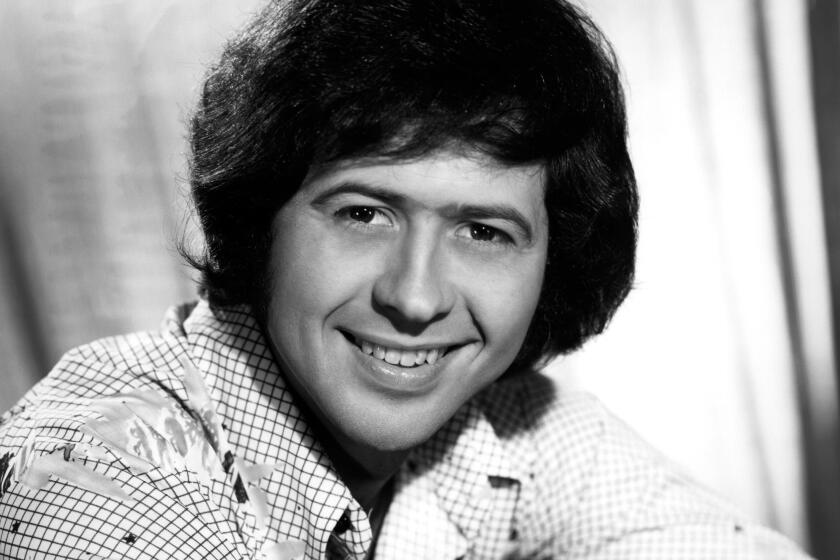Lullaby CD Is Real Sleeper
- Share via
As I write this, I am listening to Maria del Rey’s CD, “Lullabies of Latin America.”
And I am writing slower . . . and slower . . . and hoping Mama will come in soon to give me a beso . . . and tuck me in . . . and tell me that I am her . . . big . . . middle-aged . . . boy.
Sorry. When you’re writing about lullabies, you’re always in danger of sliding down the velvet tunnel to sleep--just as the occupational hazard of lullaby singers is to see their audiences nod off.
But that’s OK with Maria. In her performances, she sings lullabies, plus children’s songs that are a lot livelier. Besides, her bilingual CD brought her a nomination for best children’s album at last week’s Latin Grammys, the first such competition for Latino recording artists.
“Lullabies of Latin America/Canciones de Cuna de Latinoamerica” has sold thousands of copies. It has been played in pediatric intensive care units to calm stricken children and their parents. It has drawn the attention of the Carnegie Foundation, which brought del Rey from Ojai to New York to sing for impoverished Spanish-speaking children, who ate up the pretty Cuban American lady with the liquid voice.
So doing lullabies is not a bad gig, even for a woman who seems so intense and animated in person that you can’t picture her as a great promoter of sleep.
It also makes for an interesting marriage.
Del Rey’s husband, Jim Schaller, a composer and ex-rock musician, was searching for a musical purpose beyond entertainment. Inspired by his wife’s work with lullabies, he became a “music practitioner”--a guitarist who plays at the bedsides of the sick and dying, carefully administering music so that medication may be reduced, suffering eased, old business completed.
In their home, the lullabies play every night.
Their 8-year-old son Adam drowses off to them.
And del Rey remembers the sounds of Miami.
Exiled from Cuba in the early 1960s, her family landed in the slums.
“I’ll never forget the noise at night,” she says. “People yelling, drunks fighting, cats screeching, Elvis Presley--all these sounds, when sometimes you just need a hug, and you’d think, ‘If only I had a beautiful, nurturing sound so I can fall asleep . . .’ ”
As a kid, she was a cello prodigy. Chamber music helped put her through the University of Miami. As she grew older, she developed her voice, doing studio work with the likes of Julio Iglesias and recording a number of children’s songs.
But she didn’t forget how she longed for calm in the night’s din.
“I researched lullabies for a long time,” she says. “I’d find grandmas in L.A., New York, Miami and ask them: ‘What did your mom sing to you when you were a kid?’ ”
Most of the songs were recorded at a friend’s studio in Ojai. Musicians found an urgent reminder taped to their music stands: “Nurture!”
With a business plan in hand and stacks of CDs in her trunk, she doggedly marketed lullabies, driving from store to store up the California coast. She landed more than 40 stores before catching the eye of a distribution company that saw the potential of her nap-time niche.
Meanwhile, her husband was building a business of his own. Through Sound Covenant, he gives seminars on music and healing to clergy, doctors, nurses and caregivers of all sorts.
In two weeks, the family will move to the Philadelphia suburbs, where they have relatives. In addition, it’s an easy hop from Bucks County to the major East Coast medical centers where Schaller hopes to spread the word.
He’ll play at hospices, hospitals, nursing homes.
She’ll play at schools, libraries, bookstores.
“We’ve got the whole spectrum covered,” del Rey says. “Cradle to grave.”
“She plays ‘em in,” he jokes. “I play ‘em out.”
*
Steve Chawkins can be reached at 653-7561 or at [email protected].
More to Read
The biggest entertainment stories
Get our big stories about Hollywood, film, television, music, arts, culture and more right in your inbox as soon as they publish.
You may occasionally receive promotional content from the Los Angeles Times.











